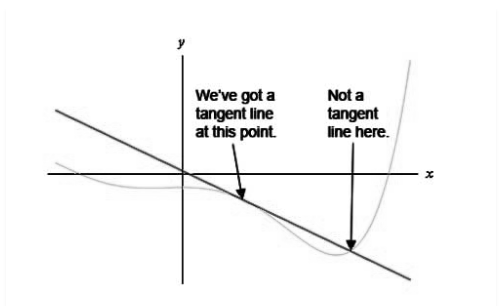
Tangent Line Formula: The line that intersects the curve at a specific point, known as the point of tangency, is referred to as a tangent line. To comprehend the concept of a tangent line, one can observe a graph. It is a line that passes through the coordinates (a, f(a)) and shares a slope equivalent to f’(a), denoting the derivative of the function at that specific point. The formula for the tangent line at any point ‘a’ on the curve is expressed as:

y−f(a)=m(x−a)
Where:
f(a) represents the value of the function at the point ‘a’
m signifies the derivative of the function at the point ‘a’
Tangent Line Formula Solved Examples
Example 1: Determine the tangent line of the curve f(x) = 4x² - 3 at x₀ = 0.
Solution: Given: f(x)=4x² - 3
f(x 0 )=f(0)=4(0) 2 −3=−3
f ′ (x)=8x
m=f ′ (x 0 )=8(0)=0
Applying the tangent line formula:
y−f(x 0 )=m(x−x 0 )
y+3=0(x−0)
y=−3 Therefore, the tangent of the curve is represented as y+3=0.
Example 2: Determine tangent line of the curve function f(x)=x 2 −2x+3 at x=1.
Given: f(x)=x 2 −2x+3
Evaluate f(1) to get the point on the curve:
f(1)=(1) 2 −2(1)+3=1−2+3=2
Find the derivative of
f ′ (x)=2x−2
Evaluate
f ′ (1) to find the slope of the tangent line: m=f ′ (1)=2(1)−2=2−2=0
Using the Tangent Line Formula
(y−y 1 )=m(x−x 1 )
with m=0 and the point ( 1 , 2 )
y−2=0×(x−1)
This simplifies to
y−2=0, and when solved for y, the equation becomes y=2.
The equation of the tangent line to f(x)=x 2 −2x+3 at x=1 is y=2.
Example 3: Determine the tangent line of the curve function
g(x)=−2x 2 +4x−1 at x=2.
Given: g(x)=−2x 2 +4x−1
Evaluate g(2) to get the point on the curve:
g(2)=−2(2) 2 +4(2)−1=−8+8−1=−1
Find the derivative of
g ′ (x)=−4x+4
Evaluate g ′ (2) to find the slope of the tangent line:
m=g ′ (2)=−4(2)+4=−8+4=−4
Using the Tangent Line Formula of a line
(y−y 1 )=m(x−x 1 ) with m=−4 and the point ( 2 , − 1 )
y+1=−4×(x−2) This simplifies to
y+1=−4x+8, and when solved for y, the equation becomes 7 y=−4x+7. The equation of the tangent line to
g(x)=−2x 2 +4x−1 at x=2 is y=−4x+7.
Example 4: Determine the equation of the tangent line to the curve h(x)= (x ) 1/2 at x=4.
Given: h(x)= (x) 1/2
Find h(4) to determine the point on the curve:
h(4)= (4) 1/2 =2
Calculate the derivative of
h ′ (x)= 1/2 (x) 1/2
Evaluate h ′ (4) to find the slope of the tangent line:
m=h ′ (4)= 1/ 2 (4) 1/2 = 1/4
Using the Tangent Line Formula of a line and the point ( 4 , 2 )
(y−y 1 )=m(x−x 1 )
(y−2)= 1/4 (x−4)
Simplify the equation:
y−2= 1/4( x−1 )
y= 1/4 x+1
Therefore, the equation of the tangent line to h(x)= x at x=4 is y= 1/4 x+1.
Understanding tangent lines involves the line that touches a curve at a specific point known as the point of tangency. This line is determined by the coordinates (a, f(a)) and shares the slope equivalent to f’(a), representing the derivative of the function at that specific point. The equation of a tangent line at any point ‘a’ on the curve is given by:
y−f(a)=m(x−a)
Where f(a) is the function value at the point ‘a’ and m denotes the derivative of the function at that same point.
Examples demonstrate how to find the equation of the tangent line to different functions at specific points on the curve. These calculations involve finding the function value, calculating the derivative, determining the slope, and applying the point-slope form of a line to obtain the equation of the tangent line.
By following this process, one can determine the equation of the tangent line to a curve at any given point, providing insight into the behavior of the function at that particular location.
Explore Now Online Course of Class 9 Neev Fastrack 2024 and Class 10 Udaan Fastrack 2024 to enhance your Maths knowledge. and build a strong foundation.
| Related Links | |
| Prime Number Formula | Product to Sum Formula |
| Profit Margin Formula | Pyramid Formula |
Tangent Line Formula FAQs
What is the tangent line formula?
How is the point of tangency defined?
What does the slope 'm' represent in the tangent line formula?
What is the significance of the tangent line in calculus?










